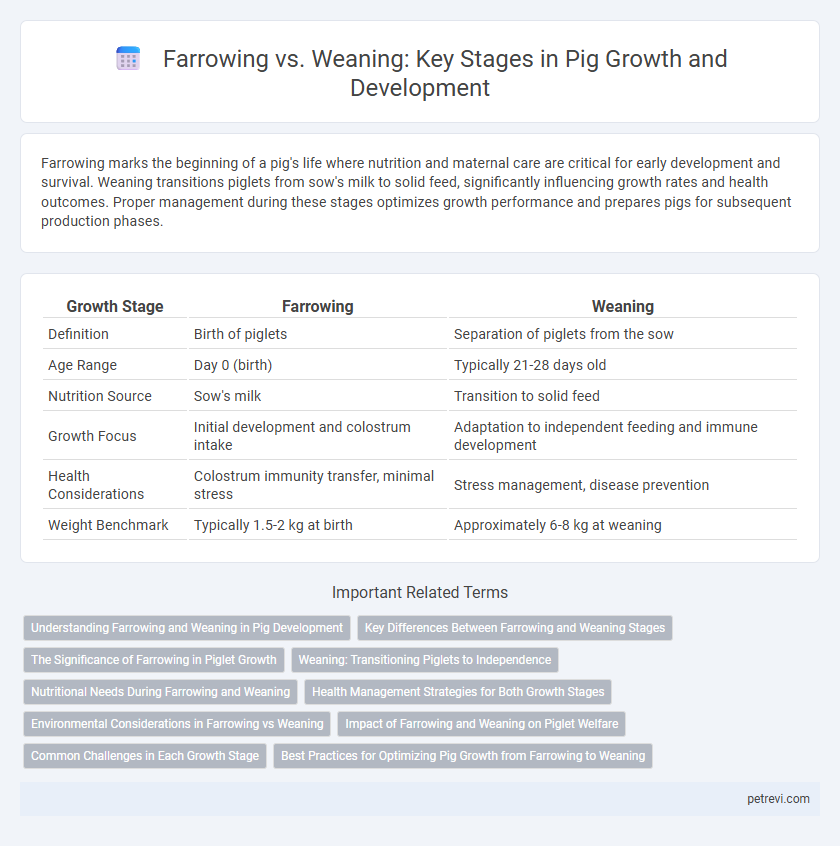Farrowing marks the beginning of a pig's life where nutrition and maternal care are critical for early development and survival. Weaning transitions piglets from sow's milk to solid feed, significantly influencing growth rates and health outcomes. Proper management during these stages optimizes growth performance and prepares pigs for subsequent production phases.
Table of Comparison
| Growth Stage | Farrowing | Weaning |
|---|---|---|
| Definition | Birth of piglets | Separation of piglets from the sow |
| Age Range | Day 0 (birth) | Typically 21-28 days old |
| Nutrition Source | Sow's milk | Transition to solid feed |
| Growth Focus | Initial development and colostrum intake | Adaptation to independent feeding and immune development |
| Health Considerations | Colostrum immunity transfer, minimal stress | Stress management, disease prevention |
| Weight Benchmark | Typically 1.5-2 kg at birth | Approximately 6-8 kg at weaning |
Understanding Farrowing and Weaning in Pig Development
Farrowing marks the birth of piglets and initiates the crucial lactation period where piglets rely on sow's milk for essential nutrients and antibodies, promoting early immune system development. Weaning occurs around 3 to 4 weeks of age, transitioning piglets from milk to solid feed, which stimulates digestive enzyme production and supports gut maturity for better nutrient absorption. Proper management during farrowing and weaning stages significantly impacts piglet growth rates, survival, and overall health in commercial swine production.
Key Differences Between Farrowing and Weaning Stages
Farrowing marks the birth and initial care period where piglets rely entirely on the sow's milk for nutrition, emphasizing warmth, immunity transfer, and early development. Weaning occurs when piglets transition from milk to solid feed, requiring digestive adaptation and increased nutrient intake to support rapid growth and independence. The key differences between farrowing and weaning stages lie in nutrition type, environmental needs, and piglet physiological development.
The Significance of Farrowing in Piglet Growth
Farrowing marks the critical beginning of a piglet's growth, providing necessary colostrum that delivers essential antibodies for immune development. This stage ensures optimal survival rates and establishes a foundation for rapid growth and health before weaning. Effective management of farrowing is crucial to maximizing piglet vitality and long-term productivity in swine production.
Weaning: Transitioning Piglets to Independence
Weaning marks a critical phase in pig growth, transitioning piglets from sow's milk dependency to solid feed intake to support independent growth and health. Proper nutrition and stress management during weaning influence gut development, immune function, and long-term growth performance in piglets. Optimizing environmental conditions and feed formulations at weaning enhances feed efficiency and reduces post-weaning growth lag, crucial for productive swine operations.
Nutritional Needs During Farrowing and Weaning
During the farrowing stage, sows require high-energy diets rich in protein, calcium, and phosphorus to support milk production and maintain body condition. Piglets benefit from colostrum intake immediately after birth, which provides essential antibodies and nutrients for early growth and immune development. At weaning, pigs need nutrient-dense feed with increased levels of easily digestible proteins, vitamins, and minerals to support gut health and rapid growth during the transition from milk to solid feed.
Health Management Strategies for Both Growth Stages
Farrowing and weaning stages in pig growth require distinct health management strategies to minimize disease risks and promote optimal development. During farrowing, maintaining strict hygiene and monitoring sows for infections like mastitis or stillbirths ensures piglet survival and vitality. For weaning, implementing gradual dietary transitions and controlling environmental stressors reduce risks of post-weaning diarrhea and support immune system strengthening.
Environmental Considerations in Farrowing vs Weaning
Optimal environmental conditions during farrowing include maintaining a temperature range of 85-90degF to ensure piglet warmth and reduce mortality, while farrowing crates help control sow movement and protect piglets. In contrast, weaning requires a cooler ambient temperature of 75-80degF to support piglet adaptation to solid feed and minimize stress-related growth setbacks. Proper ventilation and clean, dry bedding are critical in both stages to prevent respiratory diseases and promote healthy growth.
Impact of Farrowing and Weaning on Piglet Welfare
Farrowing significantly influences piglet welfare by establishing early bonding and access to maternal care, which supports immune development and reduces stress-related behaviors. Weaning introduces environmental and dietary changes that can cause stress, impacting gut health and growth rates, making careful management critical to minimize welfare issues. Optimizing the timing and conditions of both farrowing and weaning phases enhances piglet survival, health, and long-term productivity.
Common Challenges in Each Growth Stage
Farrowing challenges in pig growth stages often involve piglet mortality due to crushing, hypothermia, and inadequate colostrum intake, impacting early survival rates. Weaning introduces stress-related issues such as reduced feed intake, diarrhea, and immunosuppression, which can slow growth and increase vulnerability to diseases. Managing environmental conditions and nutrition in both stages is crucial to optimize piglet health and growth performance.
Best Practices for Optimizing Pig Growth from Farrowing to Weaning
Optimizing pig growth from farrowing to weaning involves maintaining ideal environmental conditions such as temperature control between 85-95degF during the first week, gradually decreasing thereafter to prevent hypothermia and promote feed intake. Implementing a balanced nutrition program with colostrum intake within the first 24 hours enhances immunity and growth performance, while creep feeding starting at two weeks supports gastrointestinal development and smooth transition at weaning. Regular health monitoring and minimizing stress factors such as overcrowding and abrupt dietary changes improve piglet survival rates and growth efficiency during this critical developmental stage.
Farrowing vs Weaning for Pig Growth Stage Infographic

 petrevi.com
petrevi.com